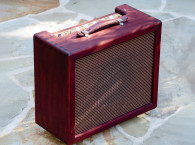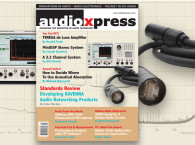 Our January 2016 issue kicks off with a great reminder of the work of analog electronics pioneers as Scott Dorsey reviews Jim Williams’ “The Art and Science of Analog Circuit Design.” A great read.
Our January 2016 issue kicks off with a great reminder of the work of analog electronics pioneers as Scott Dorsey reviews Jim Williams’ “The Art and Science of Analog Circuit Design.” A great read.Next, we jump straight to the latest on audio with our show report from the Rocky Mountain Audio Fest 2015, which Oliver Masciarotte found to be less crowded, different, upbeat, and certainly younger. He returned so impressed with what he saw and heard that it took him 9 pages just to compile the highlights and impressions!
For this January 2016 edition, we planned to dedicate our usual DIY features to practical projects oriented toward music amplification and recording. We received some truly great projects and ideas, which we have combined in this Music Focus edition.
We start with an Inexpensive Guitar Practice Amplifier, which Bruce Brown describes in detail. In this case, he salvaged old equipment and repurposed older gear to build inexpensive tube amplifiers. He started with a salvaged Heathkit IG Color Bar Dot Generator from which he used the power transformer, chassis, tube sockets, and other hardware to create a guitar practice amplifier project. You will agree the result is absolutely stunning.
Still on the subject of great guitar amplifiers, Mark Driedger submitted the idea of revisiting “The Remaking of a Champ,” inspired by Kirk Elliott’s article original article for Glass Audio (Volume 4, Number 2, 1992). In this iteration, Driedger introduces a few interesting variations, including a provision to easily try different output tubes. We recommend you read the original, which is available online here to follow-up with this great project.
Next we have The False Center Box, a project written by Scott Dorsey which was he designed for himself and has kindly decided to share with all our readers. As Scott describes, “The design enables you to build a passive mixing device that takes in two channels of microphone signals and passes them directly on to the output. It can also combine them with an attenuated and isolated line level signal that is equally sent to both channels.”
Remaining with Music-oriented projects - and again related to tubes and guitar amplifications - Peter Delos writes about a Switching Power Supply Design for Tube Amp Applications. The topic might seem a little strange at first, but as Peter explains, the goal is to reduce the weight, the cost, and the size of the 60 Hz transformers used to create the high voltage in tube amplifiers. This useful design is made with readily available parts and we are certain the result will inspire many to try it. Peter Delos showed us the end result, with a unique tube sound, no hum or noise, and half the volume of a normal tube head.
And because this is a Music-focused issue, Shannon Becker decided to do something special. You might have noticed already the stunning microphone on our cover. No, it's not a vintage mic. It is the Myrtle - a modern microphone proudly designed and manufactured in Portland, OR. In this issue, we speak with Philip Graham, the founder of Ear Trumpet Labs and principal creator of those stunning microphones.
You might have noticed that we have been exploring current options for Practical Test & Measurement, using modern mobile devices. We all have smartphones and tablets these days and those touchscreens make great interfaces and all we need are professional solutions that we can actually use in a reliable way. That’s exactly what Stuart Yaniger found with the iSEMic 725TR Measurement and Recording Microphone from iSEMcon.
For months now, Richard Honeycutt has focused on equipment and software for making acoustical measurements. This month, his Sound Control article discusses the most crucial factor in making good measurements: the people doing the measuring. He starts by looking at SPL, the most commonly used acoustical measurement, and identifying processes by which we can make accurate measurements and avoid common pitfalls.
Finally, for those interested in designing the latest generation of audio products, our Standards Review article continues to detail how to implement audio networking. In Fundamentals of Audio Networking, the second article in this series, we dive into the history of one of the most successful early audio networking technologies - CobraNet - and reveal some of the pioneering work of the companies who faced the first hurdles while trying to convince the market about the benefits of networking technologies.
As always, there are plenty of reasons to start exploring your new issue of audioXpress, now available at www.gotomyxpress.com
To become a member, visit www.audioxpress.com/page/audioXpress-Subscription-Services.html
You can also buy a single printed issue at www.cc-webshop.com






